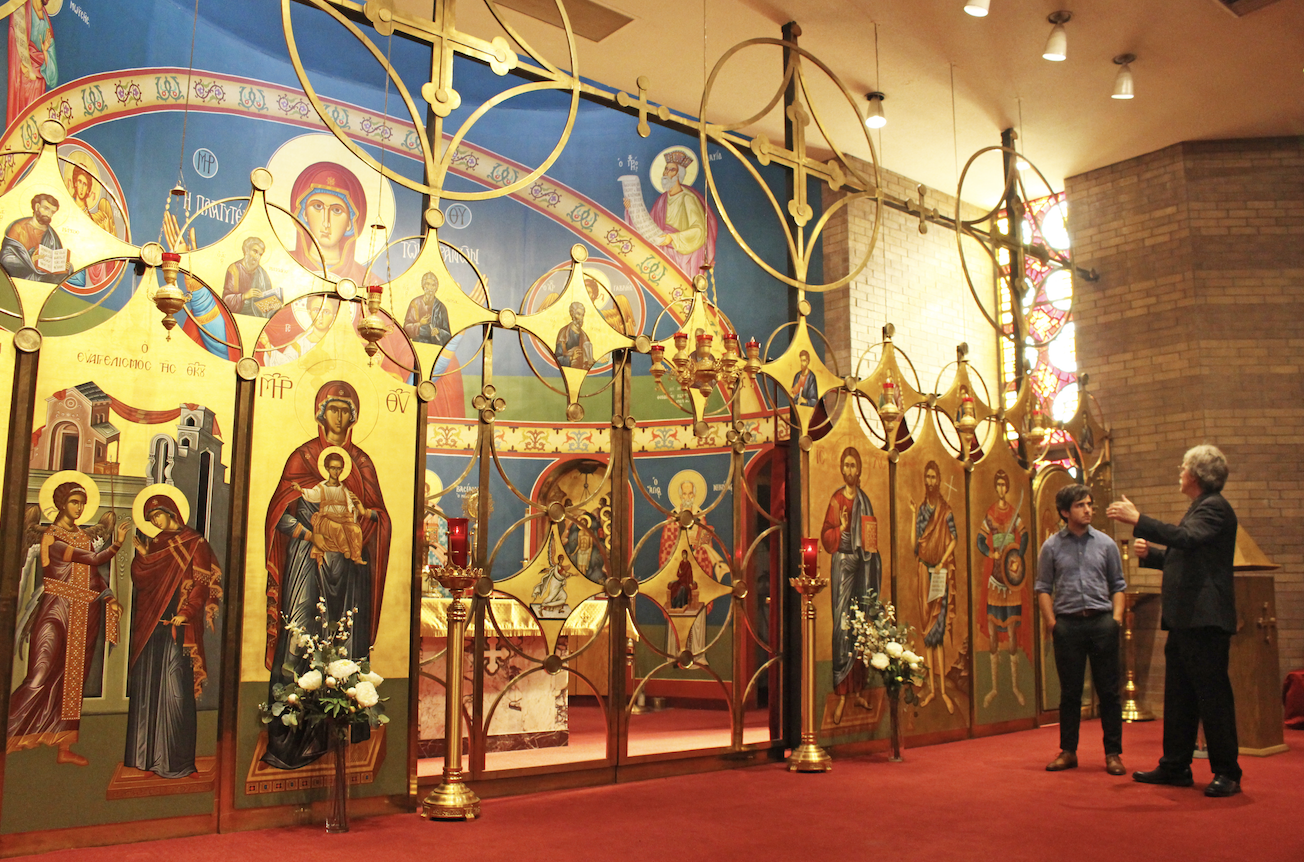![]()

Filing quietly into the service, students entered a sacred space surrounded by images of Christ. and saints while the echoes of chants and clouds of incense hung in the air. Worshippers kissed icons of Christ and received the Eucharist while students observed their reverence and awe through both similar and unfamiliar forms of worship during an experiential learning trip.
As a part of the Honors Integrated Theology course, John Brown University students visited two Eastern Orthodox churches and the Nelson-Atkins Museum of Art in Kansas City, Missouri, on Nov. 9 to 10. David Vila, professor of religion and philosophy, and Cary Balzer, professor of theology, co-led both the trip and the class.
Kara Peterson, senior family and human services major, enjoyed the immersive learning experience. “I loved the full-body experience, the best way Vila put it—the use of the incense, the bells, the icons,” Peterson said. “We didn’t partake in the Eucharist, but even all of the senses being utilized within worship, that was really fun. The chanting of the whole liturgy, instead of just reading it, gave it a lot more flavor and beauty in some ways.”
Vila and Balzer organized this trip to help expand students’ understanding of Christian theology and practice. “We wanted students to encounter a worship experience that was different from what they are accustomed to. Roman Catholic churches are more common, and there are numbers of Roman Catholic students at JBU, so we decided to go Orthodox,” Vila said. “We wanted to tie the church visit to an art museum that had a good collection of medieval, Christian art. And so, we narrowed it down to KC and the Nelson Atkins.”
During the tour of the Nelson-Atkins museum, groups viewed religious works, beginning in the Egyptian period. In this section, Peterson found one image fascinating. “We stopped by this showcase of a mummy and there were a couple of Egyptian idols above it. The docent went through what the names of gods were and stuff like that,” Peterson said. “On the left side, it
was a figure of Isis … she was holding a baby. It was really interesting to see that kind of picture. that was very similar to the picture of the virgin with the child, in a different culture, very separate from each other but the fact that both of these cultures still had something similar to each other was fascinating and pointed to the revelation of God in different cultures despite not having a Bible.”
The tours also examined works from the Renaissance, Middle Ages and Roman periods, preparing students for viewing iconography of the Orthodox churches. “We went from being very flat and like people stood up for a portrait to John the Baptist in the Baroque period. There were lots of angles, shadows, light and visual movement,” Balzer said. “Then when we go to look at the icons both in the museum and in the church, they were flat. We are reminded that that’s the period out of which the art emerged.”
Later in the weekend, the class visited two different types of Orthodox churches. First, they attended a Vespers service at Holy Trinity Orthodox Church, which belongs to the Orthodox Church in America. They then attended a Sunday morning service at Annunciation Greek
Orthodox Christian Church.
Drawing from the experience in the museum, Emily Alsop, senior international business major, appreciated the symbolic nature of Orthodox worship. “It makes you realize it’s not just a work of art, it’s not just something that someone did here on earth,” Alsop said. “They did it so that
there would be more of a spiritual impact, too.”
Balzer emphasized how worshipping in a new environment can have an impact on students. “In some ways, the Orthodox church gives a more vivid comparison and picture of another Christian tradition that really is of course similar to Evangelicalism and Protestantism, but it is so different in many ways,” Balzer said. “Especially the worship service is so different from what most of our students are used to, coming out of an Evangelical and, for many, a reformed background. To see all the icons and to have the sensory extravaganza of incense and sights and smells and sounds, all of that is such a rich experience. It’s also a cultural experience.”
“What always strikes me in the American Orthodox church is how, when the worshippers enter the sanctuary, they walk up the center aisle and bow three times, kiss the icon of Jesus, back up, bow three more times, and then go take their seat,” Balzer said. “That is so different from how Protestants or Evangelicals enter the sanctuary. We walk in any door we want, go sit in the pew. We might chat. And not that one is necessarily better than the other. Both are expressive of their culture, but I do think that sense of awe and adoration and worship are admirable.”
This adoration is a key learning point for Balzer. “Liturgy means the work of the people and in that Eastern tradition that we saw, they take the work seriously. Maybe it’s that as Evangelicals and Protestants we … are careful not to make it about works, but I thought the emphasis on worship was extremely meaningful and awe-inspiring and it is to be taken seriously. We can learn from that.”
Peterson believes it is important to step into someone else’s experience of faith through changing surroundings. “Otherwise we are never going to get a fuller understanding of who God is if we are not willing to experience it through other lenses.”
Photo: Catherine Nolte, The Threefold Advocate





